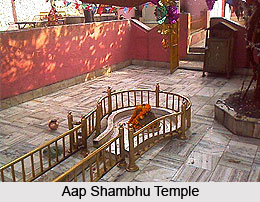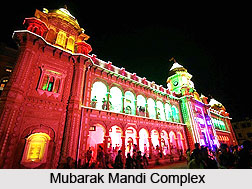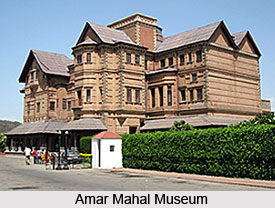 Tourism in Jammu District is full of sightseeing options including visits to several holy sites as well as historical monuments. The natural beauty of the region enhances the charm of travelling experience of the tourists who are coming from distant places. Tourism in Jammu District is mainly for its religious sites and Jammu city is also called as the land of temples. Some of the main attractions of Jammu District are as follows -
Tourism in Jammu District is full of sightseeing options including visits to several holy sites as well as historical monuments. The natural beauty of the region enhances the charm of travelling experience of the tourists who are coming from distant places. Tourism in Jammu District is mainly for its religious sites and Jammu city is also called as the land of temples. Some of the main attractions of Jammu District are as follows -
Pilgrimage Tourism in Jammu District
Ziarat Baba Buddan Shah: Located in the outskirts of Jammu city at a distance of about 8 kms towards the aerodrome at Satwari. This shrine is very popular among all sections of society.
Ziarat Peer Mitha: In the heart of Jammu city there is a magnificent tomb along with a mosque.
Panch Peer: This Dargah is situated at a little distance from the Maharaja`s palace on the Jammu-Srinagar National Highway. The place is as known because of the residence of five peers (holy men), lived here and dedicated them to the meditation.
 Peer Khoh: This cave shrine of Lord Shiva also known as Jamawant cave is said to be the oldest historic place in the Shivalik region. Located amidst igneous rocks and acacia jungle in North-East of Jammu city on the side of circular road above Tawi river, the history of the cave is said to be connected with epic-age.
Peer Khoh: This cave shrine of Lord Shiva also known as Jamawant cave is said to be the oldest historic place in the Shivalik region. Located amidst igneous rocks and acacia jungle in North-East of Jammu city on the side of circular road above Tawi river, the history of the cave is said to be connected with epic-age.
Aap Shambhu Temple: It is a temple situated at Sathrian in Roopnagar area of Jammu city. The stone temple has self-made stone Lingam. Several legends are associated with this temple.
Raghunath Temple: Located in the heart of Jammu city, this complex is the most splendid temple complex in northern India. The main commercial market of Jammu is named after the temple complex. The complex consists of 17 temples. However, it was named after the main temple of Lord Rama, Sita and Lakshmana as the Dogra dynasty is believed to be the descendant of Lord Rama.
Gadhadharji Temple: Maharaja Gulab Singh also constructed a Gadhadhargi temple near his palace (Mubarak Mandi) soon after becoming the ruler of the state.
 Ranbireshwar Temple: Located on the Shalimar Road this temple was built by Maharaja Ranbir Singh in1883 AD. Ranbireshwar Temple is dedicated to Lord Shiva. It has one central `Lingam` measuring seven and a half feet height.
Ranbireshwar Temple: Located on the Shalimar Road this temple was built by Maharaja Ranbir Singh in1883 AD. Ranbireshwar Temple is dedicated to Lord Shiva. It has one central `Lingam` measuring seven and a half feet height.
Leisure Tourism in Jammu District
Mubarak Mandi Complex: The complex is housing 76 government offices and courts. The complex has a history as old as 150 years old. It was a royal residence of Dogra rulers. The palaces are built as a group of buildings around the courtyard. Successive Dogra rulers added to the complex in size. The buildings were used as the residences of the royal Dogra families. The complex has halls and galleries which were used for official functions and public events. The oldest building in this Palace complex dates back to 1824. The architecture is blend of Rajasthani, Mughal and even Baroque European influences. The most stunning segment is the Sheesh Mahal. The Pink Hall now houses of Dogra Art Museum which has miniature paintings of the various Hill Schools.
Bahu Fort: 5 kms from Jammu city situated on a rock face on the left bank of the river Tawi; this is perhaps the oldest fort and edifice in the city. Constructed originally by Raja Bahulochan over 3,000 years ago, the existing fort was more recently improved and built by Dogra rulers. There is a temple dedicated to Goddess Kali inside the fort popularly known as Bave wali Mata. Bave Wali Mata is the presiding deity of Jammu. One can really imagine; on looking at the fort; the wars fought, the invasions prevented and even the grandeur of the Royal families. Today the fort is surrounded with beautiful terraced garden which is favourite picnic spot of the city folk. It has waterfalls, flowers and big trees.
Rani Charak Mahal: This historical palace is also located on river side, connected with Toshakhana on one side.
 Amar Mahal Museum: Is a beautiful palace of red sand stone which stands amidst most picturesque horizons of Jammu. Once the residential palace of Raja Amar Singh, the palace has now been converted into a museum. The museum still has the golden throne on which Maharaja used to sit. The museum has a gallery of paintings known as the `Naldamyant` and a library in which about 25,000 books on various subjects and disciplines have been presented. One can have a beautiful view of the Shivalik Hills at the north and the River Tawi flows down below adding to the grandeur. This was once the residential palace of Raja Amar Singh.
Amar Mahal Museum: Is a beautiful palace of red sand stone which stands amidst most picturesque horizons of Jammu. Once the residential palace of Raja Amar Singh, the palace has now been converted into a museum. The museum still has the golden throne on which Maharaja used to sit. The museum has a gallery of paintings known as the `Naldamyant` and a library in which about 25,000 books on various subjects and disciplines have been presented. One can have a beautiful view of the Shivalik Hills at the north and the River Tawi flows down below adding to the grandeur. This was once the residential palace of Raja Amar Singh.
Dogra Art Museum: It is presently located in the Pink Hall of Mubarak Mandi Complex. The Museum houses about 800 rare and exquisite paintings from different schools of paintings. The museum also has hand written manuscripts of Shahnama and Sikandernama both in Persian. Gold painted bow and arrow of Shah Jahan and a number carpentry tools constitute an important section of the display.
Nature Tourism in Jammu District
Akhnoor: 32 kms south west of Jammu situated on the banks of mighty Chenab river is the historic town of Akhnoor. This town is associated with the legend of Soni-Mahiwal. Ruins of the Indus Valley Civilization are to be seen along the river bank commanding a panoramic view all around
Jhajjar Kotli: On the National Highway leading towards Srinagar is the Jajjar Kotli Tourist Complex, built on the banks of Jujjar rivulet. The crystal clear, cool water of Jhajjar attracts tourists in large numbers during the summer.
All these tourist attractions of Jammu District are worth exploring and they transform the travelling experience of the tourists into an enriching and memorable one.



















